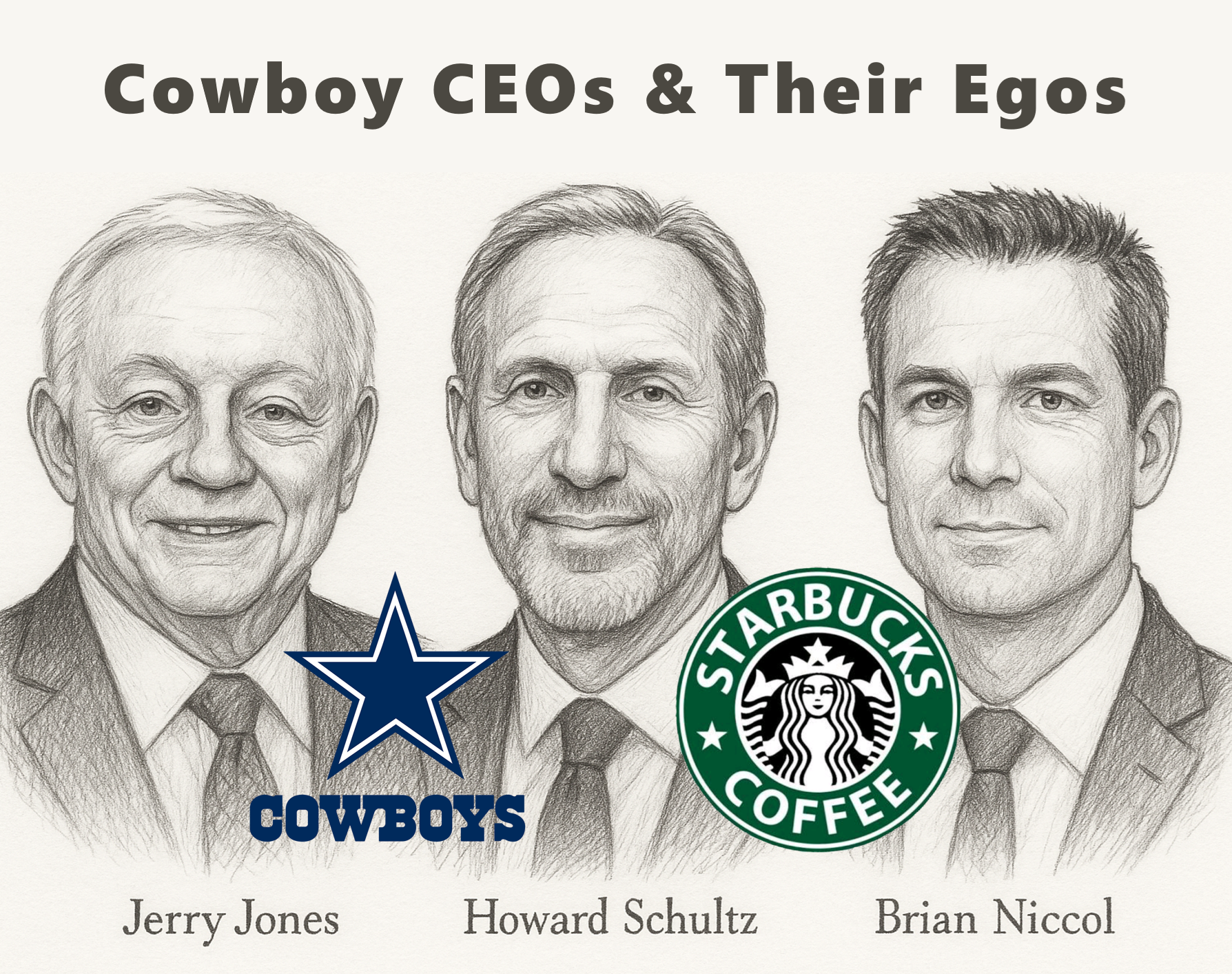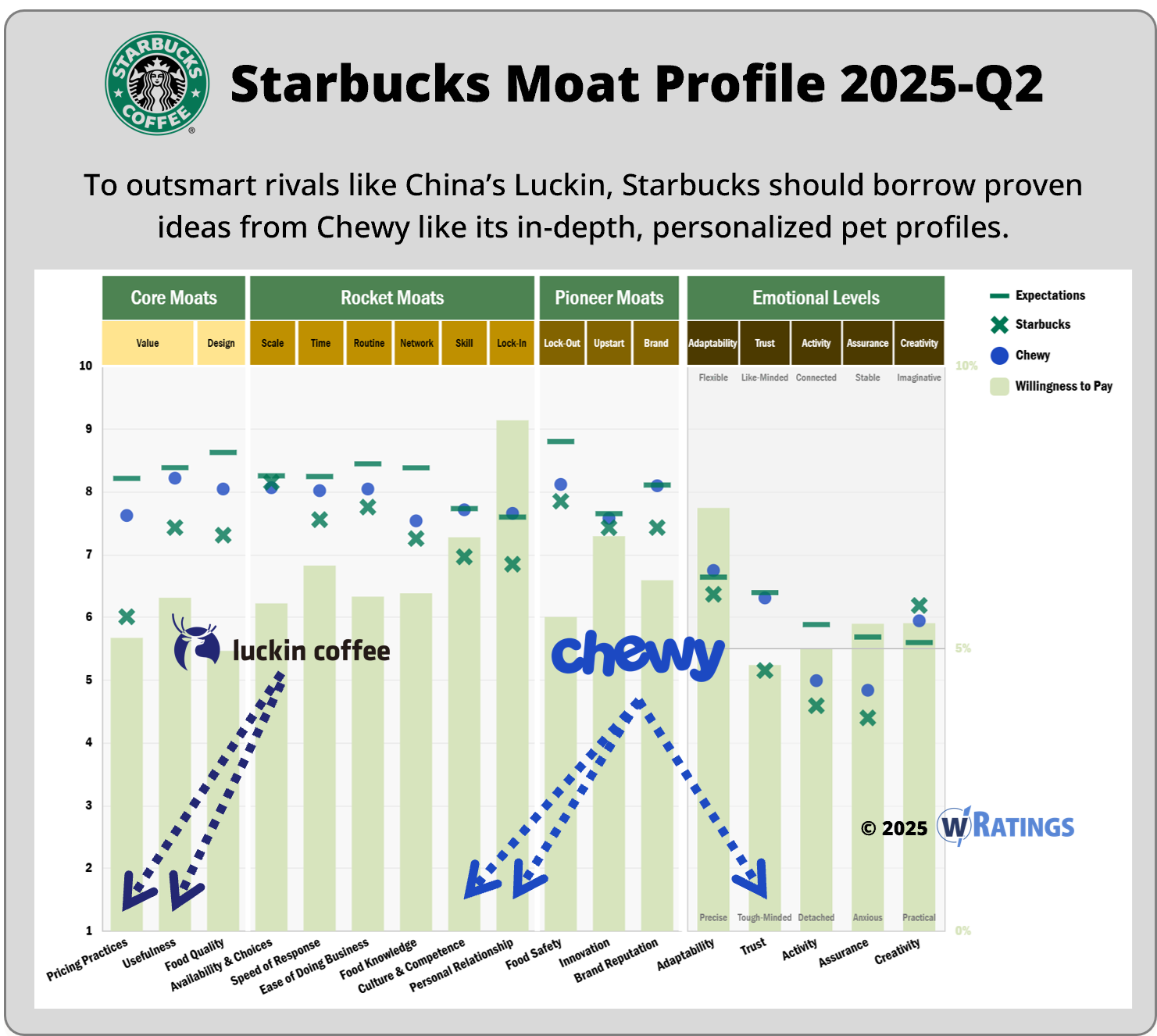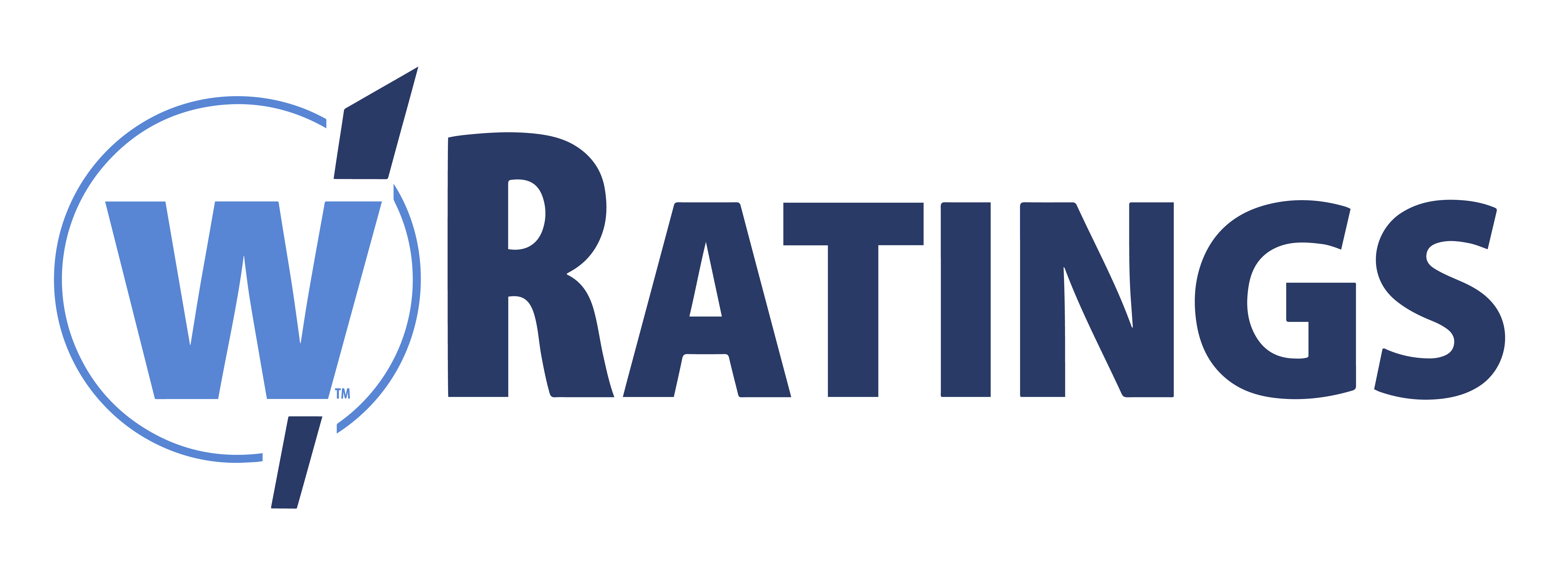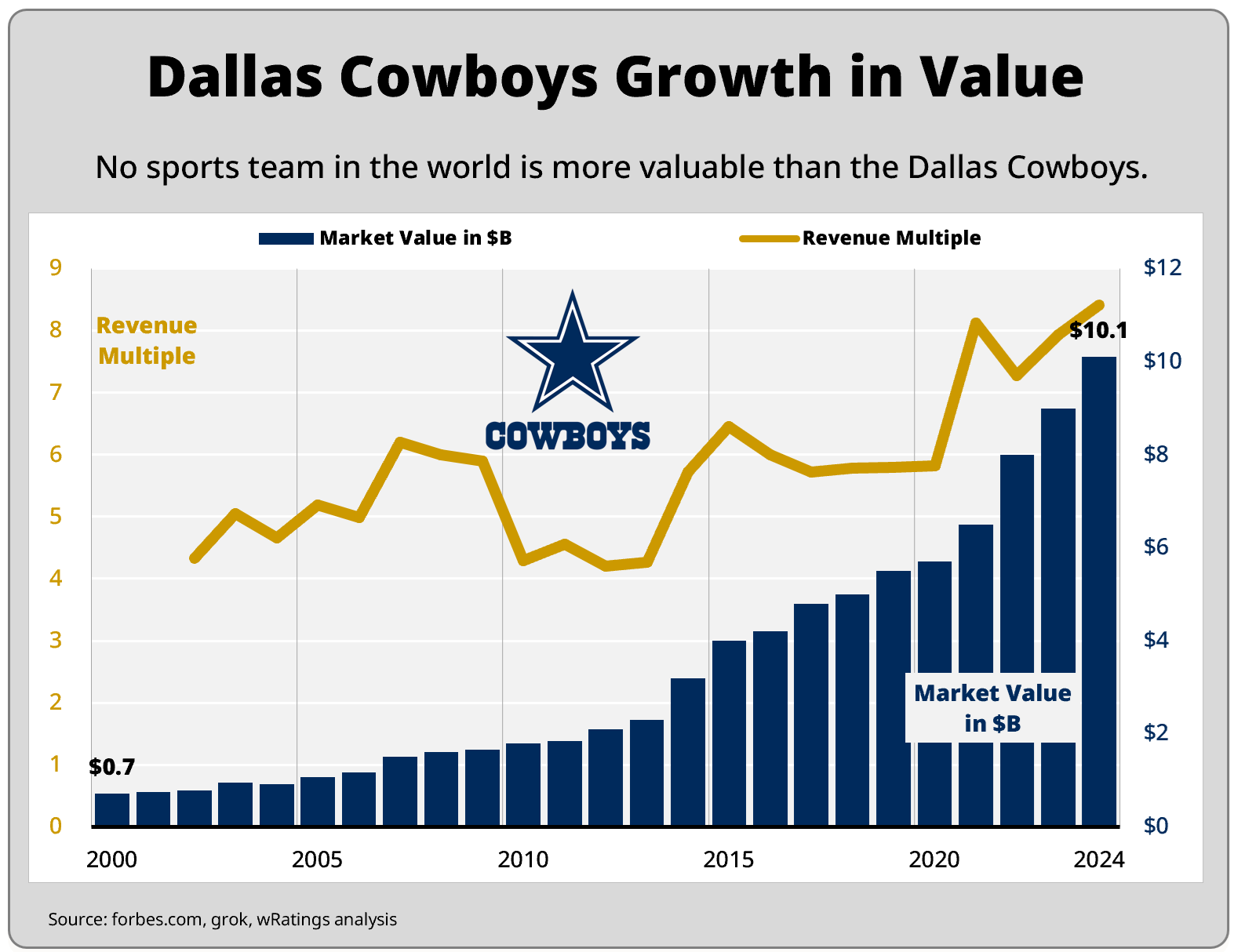Cowboy CEOs: Jerry Jones, Howard Schultz and the Pursuit of Power
Gary A Williams
July 28, 2025
Cowboy CEOs: Jerry Jones, Howard Schultz and the Pursuit of Power

All trademarks are properties of their respective owners.
Lots of successful business executives have ventured into sports to buy a team. To name a few: Steve Ballmer (Microsoft / LA Clippers), Rob Walton (Walmart / Denver Broncos), Daniel Gilbert (Rocket Mortgage / Cleveland Cavaliers), and Steve Cohen (Hedge fund / New York Mets).
One team owner stands well above the rest today. In 1989, oilman Jerry Jones bought the Dallas Cowboys for $140M. And despite not winning a Super Bowl since 1996, the Cowboys have been the most valuable sports franchise in the world for nine consecutive years. Current valuation is $10.1B with a growing revenue multiple now at 8.4X.
Yet, Jerry Jones is not happy. In a recent quote, he said “When I look back on my life, I overpaid for my big successes every time. And when I tried to get a bargain, get it a little cheaper or get a better deal on it, I ended up usually either getting it and not happy I got it. Or missing it.”
Maybe Jerry’s unhappy because he doesn’t have the right playbook – not for football but something much more foundational: culture. He could borrow from Starbucks’ Howard Schultz playbook, and he might be happier . . . and likely even wealthier.
When Shultz struggled to grow Starbucks in the 1980s, he put his ego aside and hired a VP of Sales/Operations in 1989 that was essentially the polar opposite of him. By 1995, store count grew from 28 to 400+ stores. Today, there are more than 17,000 Starbucks in the US.
All because Howard Shultz decided to bring in someone to build culture around customer service.
Jerry Jones: Power over Winning
When Jerry Jones bought the Dallas Cowboys in 1989, he fired longtime coach Tom Landry and general manager Tex Schramm to take complete control of the franchise. As the Cowboys GM, he brought in college teammate Jimmy Johnson as head coach. After a disastrous start, the duo won the Super Bowl in 1992 and 1993.
But Jerry’s ego got the best him, saying too much of the limelight was being put on Jimmy Johnson, famously saying any coach could have won those Super Bowls. So he fired Johnson and hired former University of Oklahoma coach Barry Switzer in 1994, and the Cowboys won it all again in 1995.
Since that 1995 season though, mediocrity has set in. Just don’t tell anyone that puts valuations on sports teams.
Jerry gets to play Monopoly every day with real money. In 2024, the Cowboys generated $1.2B in revenue and $564M in operating income, according to Forbes. Their $10.1B valuation is the first sports franchise to break the eight digit threshold.
Yet, Jones manages the team like its going broke. He pisses people off trying to get what he wants. Just ask Micah Parsons, Dak Prescott, CeeDee Lamb, Ezekiel Elliott, Dez Bryant, and Emmitt Smith. Their contracts have all been negotiated in public, and against an owner that holds all the cards.
The result is a culture where no one feels like they are on a team. Oddly, this is not about trying to save a few dollars. This is about power. Jerry needs it and just can’t help himself. He will likely never give it up.
In May 2002, Harvard Business Review published my research article on how leaders make decisions, “Change They Way You Persuade”. Jerry Jones falls in the Controller category (9% of all executives), where they rarely change their mind unless they are forced to do so. The best way to persuade Controllers? Let an expert present the facts. And then wait. They need to convince themselves. No doubt Jerry wants to win, but only if he wins his way.
Maybe he could reach out to Howard Schultz, who is an expert and a winner.
Howard Schultz: Winning over Power
Just a few years after Jones bought the Dallas Cowboys, CEO Howard Schultz took Starbucks (NASDAQ: SBUX) public in 1992 to create “the third place between work and home.” He is often credited with creating the premium coffee category.
During his three stints as CEO (1986-2000, 2008-2017, 2022-2023), Schultz pursued an aggressive expansion of Starbucks to make it into the global brand it is today. And like other successful CEOs, he joined the sports team owner club in 2001 and bought the NBA’s Seattle Supersonics.
Similar to Jerry Jones, Schultz faced a lot of criticism during his tenure as tried to wield his power over others. He feuded with players publicly and said he needed $200M from the state to renovate KeyArena. He didn’t get it.
Losing this power struggle, Schultz sold the team to an Oklahoma City business group, who moved the team to their state a mere two years later. The sale and move were not exactly a fan favorite for those in the Pacific Northwest – something Schultz says he has learned from today.
The strange thing about the sale is that Schultz should have known better than to let his ego get in the way. He didn’t let that happen at Starbucks and, well, it certainly worked out quite well for everyone.
Back in the 1980s as Schultz was trying to rapidly open up stores, customer service was slipping. Rather than ignore the issue, CEO Schulz realized he lacked the expertise in customer service yet needed it to meet his growth goals. So in 1989, he set his ego aside and hired Howard Behar from the outside to fix it.
Schultz thought culture was important but not critical. Behar, a complete opposite from Schultz in both looks and temperament, knew that employee morale and customer service were the key to scaling the company. It worked.

Ironically, Starbucks today is going through another rough patch due to its culture and customer service. Last year, new CEO Brian Niccol came in from Chipotle to turn the company around.
Based on recent customer data, Starbucks is still struggling in two critical areas for growth: Culture & Competence and Personal Relationship. Trust levels are also far off what customers expect.
To add to the challenges for Starbucks, the largest coffee chain in China, Luckin Coffee, has opened up its first two stores in the US – both in New York City. Luckin is attacking Starbucks with a unique customer value proposition around pricing/coupons and its mobile app ordering.
Comparing perception of Starbucks customers with Chewy customers, new CEO Niccol may want to borrow some ideas from Chewy. Chewy, the online pet retailer, uses in-depth pet profiles to tailor recommendations, something Starbucks could expand with their own customer profiles to generate personalized suggestions. Starbucks could expand their auto-reload card to emulate Chewy’s AutoShip program with more predictive perks such as exclusive flavors.
Chewy is well-known for its 24/7 human-led customer service, often sending condolences or flowers for pet losses. Baristas could be more empathetic and listen closely to customers sharing a personal story about having a tough day – and then offer a complimentary upgrade or write a special note.
Starbucks needs to improve customer services, and borrowing these proven ideas from Chewy could accelerate their turnaround and growth.
Winning
Let the wRatings platform analyze where you win – and could be winning – with your customers today.
You will be able to clearly see their expectations, your company performance versus key rivals, and how much more customers are willing to pay so you can grow revenues and margins today.
Don’t wait. Apply to become a wRatings Insider today.



